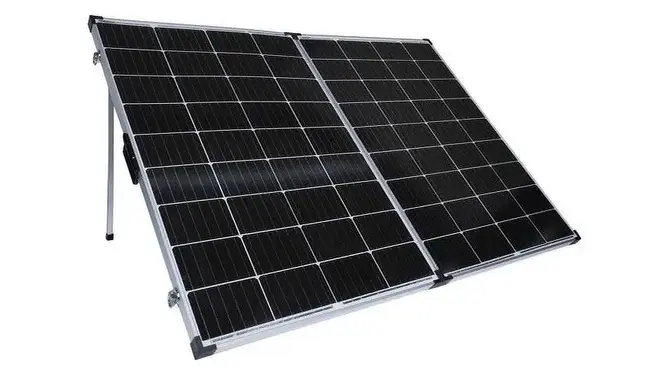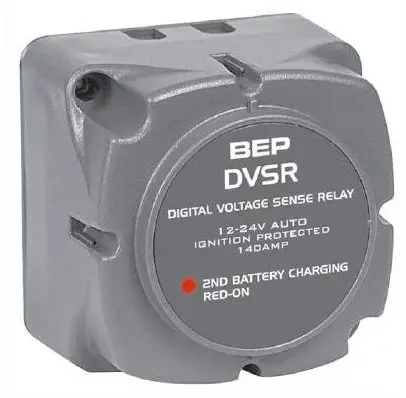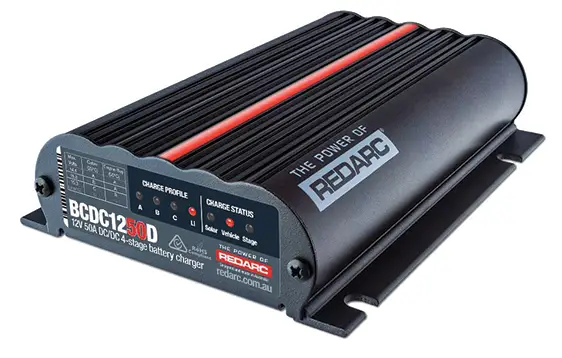Click on image for full view and caption
All you need is a solar panel, a solar controller, and a battery.
Solar basics for dummies
Wayne Ravelich
The sun is a wonderful free resource that provides, heat, warmth, and with the use of modern solar panels, also power.
Solar power for us campers is a simple process. All you need is a solar panel, a solar controller, and a battery. The panel converts the sunlight into electricity. The controller takes that electricity and transforms it to a source of energy that can be used to charge the battery. The battery then stores that electrical energy until it is required to be used.
Effectively the solar panel and controller are just a fancy battery charger. The battery supplies your power to run the lights, the inverter, if you have one, and any electrical devices. During peak sun hours some power will be supplied directly from the controller. Saying that, the important thing to remember is that most of the power you use comes from the battery.
Solar panels

Solar panels are the first link in the power chain and come in a variety of styles.
• Rigid, the most common style and most efficient.
• Flexible, light weight.
• Portable, either folding ridged type or blanket, with built in controller.
Solar panel output deteriorates with age and dirt, so keep the panels clean— just a light wash, don’t scrub. Panel output has improved greatly in the last few years. An old 75W panel may only produce 40W but a new 150W panel could fit in the same space (from experience). The biggest problem I come across is not enough solar to keep the batteries charged. Solution is ADD more solar, either fixed, if space allows, or a portable panel.
Solar controllers
Controllers come in two types.
• PWM (Pulse Wave Modulation): the least efficient but cheaper and good for small panels.
• MPPT (Multi Point Power Tracking): the best by far but more expensive.
Batteries
Batteries come in lots of types for different uses. In a solar power system, we use the “deep cycle” batteries. A car battery is not deep cycle but would work, for a while. Car batteries are designed to start cars, high current 400 to 800amps for a few seconds. Deep cycle batteries provide lower current (amps) continuously, a 100ah (amp hour) battery will provide 10amps for 10 hours. A 200ah battery will provide the same 10amps for 20 hours. The more power you need, the bigger or more batteries you require. Two 100ah batteries connected in “parallel,” that is positive to positive and negative to negative, gives you 200ah.
Having lots of batteries give you lots of storage and lots of potential power, BUT you will need lots of solar panels to keep the batteries charged. The rule of thumb is twice the amp hours equals the minimum solar panel size. A 100ah battery needs 100 X 2 = 200Watt panel to fully charge the battery.
Let’s look at battery types.
◼️ Lead Acid batteries are similar to your car start battery with lead plates and sulphuric acid.
◼️ AGM batteries (Absorbed Glass Mat) is also lead plates and the acid is absorbed into a mat to stop it sloshing around.
◼️ GEL Batteries are designed not to emit gas during charging and are similar to the AGM, but they can be used on their side or standing up.
◼️ Lead-carbon batteries are an advanced lead acid battery which use a common lead positive plate (anode) and a carbon composite negative plate (cathode). The carbon acts as a sort of ‘super capacitor’ which allows faster charging and discharging, plus prolonged life at partial state of charge.
◼️ Lithium Batteries come in a couple of formats, Lithium Nickel Cobalt Aluminium Oxide batteries are the more common “cheaper” lithium battery and not as safe as some other forms of Lithium battery. The LiFePO4 (Lithium iron phosphate) batteries are a bit more expensive but are the safest of them all. LiFePO4 batteries generally have a BMS (Battery Management System) built in and will shut the battery down if there is a problem.
Controllers and chargers
Solar controllers have settings for the different battery types as the batteries charge differently. You cannot mix battery types in your solar system. A lot of solar controllers do not have a Lithium setting so check first. The same applies to battery chargers.
Topping up your “house” battery from the “start” battery or alternator is a good idea and can be done in motor homes and caravans. For lead acid batteries I recommend the use of a Dual Voltage Sensitive Relay (DVSR) to prevent the start battery going flat. If you have Lithium “house” batteries, you need to use a DC/DC charger (below, right) set to ‘lithium’. A standard battery charger or car alternator provides 13.8Volts, but lithium needs 14.6Volts minimum to fully charge.
A little on inverters
Inverters convert 12V DC from your battery into 230V AC to run your domestic appliances. Inverters come in two types, modified sine wave and pure sine wave inverters. Pure sine wave inverters are dearer and far better than modified sine wave. If you are going to be using electronic appliances get a Pure Sine Wave inverter. The inverter needs to be as close as possible to the battery and have BIG supply cables. A 2kW fan heater draws 8amps from the inverter, the inverter draws 170amps from the battery so the battery cables must be large enough to carry that load or you will have a fire.
Fuses and circuit breakers for safety need to be everywhere. From the solar panels to the controller, from the controller to the battery and from the battery to the load and/or inverter.
Sunlight
A last note, solar power needs sunlight. Solar works great in the summer. In winter there is a lot less sun and the cold can affect the batteries. Also, the further south you go the less sun there is to charge your system. Overall having a good solar system in your camper makes for better, easier camping.
If in doubt
If in doubt, ASK a specialist that knows solar. Facebook is not a specialist.
I hope this helps you better understand the magic of solar power. ◼️
Images are product photos.

9 Spring 2024
, p
9



